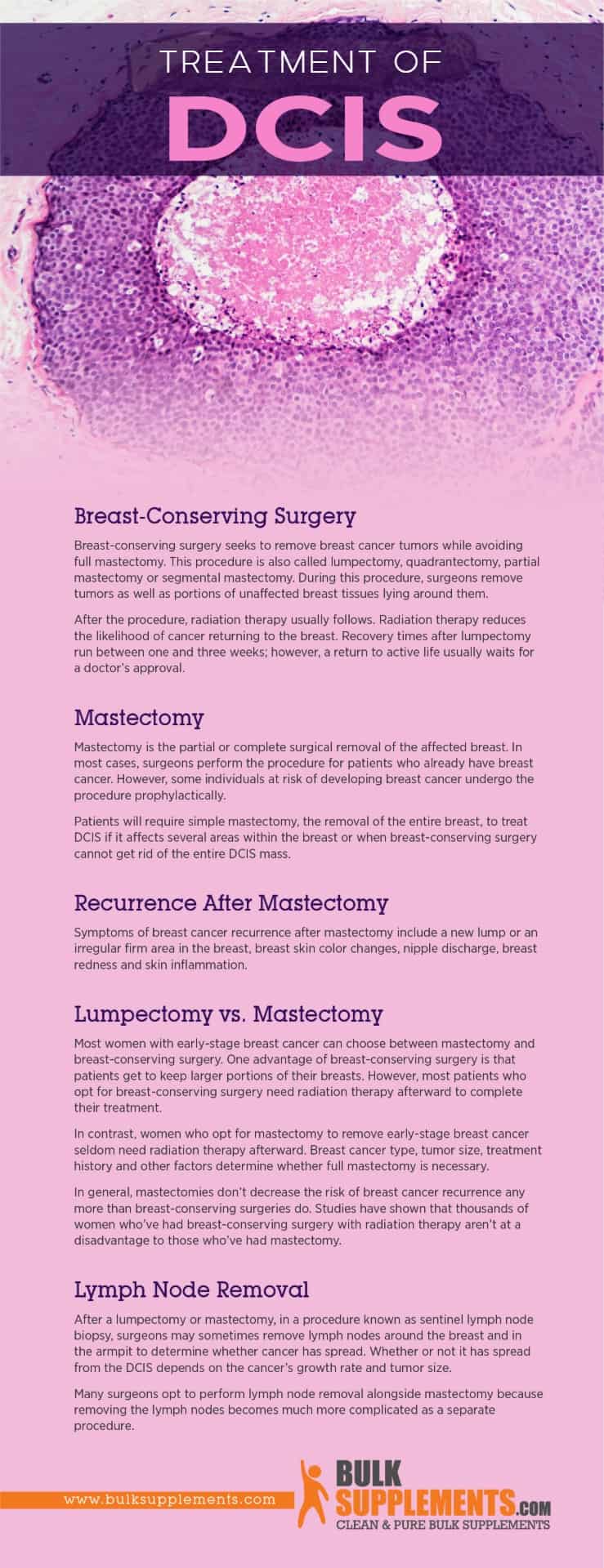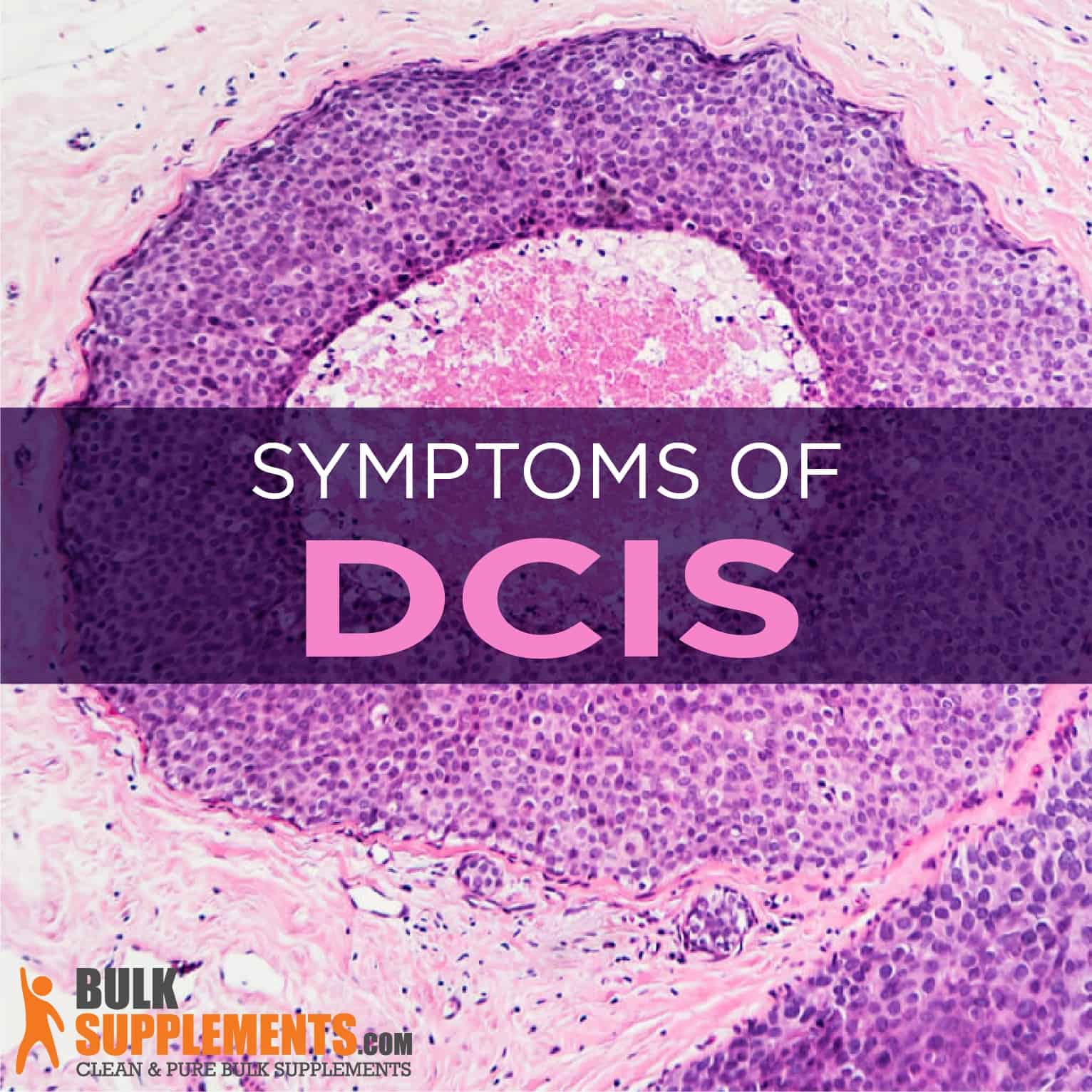What is Ductal Carcinoma in Situ?
Ductal carcinoma in situ (DCIS) is breast cancer of the milk ducts. This type of cancer is non-invasive, meaning that it hasn’t traveled into the surrounding breast tissue at the time of its diagnosis. (x) In contrast, invasive mammary carcinoma spreads rapidly, eventually taking over the entire mammary gland. Even though DCIS is non-invasive, it still needs urgent treatment to prevent its degeneration into invasive breast cancer.
Sometimes, breast calcifications, tiny calcium deposits in breast tissues are an early sign of DCIS. On mammograms, breast calcifications, common among women older than 50, usually show up as white flecks or spots. (x) They are typically benign. However, tight clusters of breast calcifications may show precancerous changes within breast tissues or may reveal the presence of breast cancer itself.
If you have breast calcifications, consider applying essential oils to your breasts with a carrier oil like coconut. Frankincense works well in softening the condensed tissues. (x)
Other workable oils are thyme, lemongrass and chamomile. (x) (x) A study supports the use of Juniper oil to prevent breast cancer. (x)
Five Stages of Breast Cancer
There are five stages of breast cancer. DCIS is a stage zero breast cancer where abnormal cells line the milk ducts within the breast. It’s a very early cancer with a high likelihood of treatment success. According to a study published in the Journal of the National Cancer Institute Monographs, only 1 to 2.6 percent of women with diagnosed DCIS will die from invasive breast cancer. (x)
Intraductal Papillomas
Intraductal papillomas are small benign tumors that grow in the milk ducts of the breast. (x) Though they aren’t cancerous, large numbers of them may show breast cancer. Removing intraductal papillomas requires surgery and usually involves removing the milk ducts with the tumors.
DCIS Treatments
Treatment for breast cancer is vital to know about if you are a woman, and understanding various DCIS treatments helps. Traditional treatments include:
- Breast-Conserving Surgery
Breast-conserving surgery seeks to remove breast cancer tumors while avoiding full mastectomy. This procedure is also called lumpectomy, quadrantectomy, partial mastectomy or segmental mastectomy. (x) During this procedure, surgeons remove tumors and portions of unaffected breast tissues lying around them.
After the procedure, radiation therapy usually follows. Radiation therapy reduces the likelihood of cancer returning to the breast. Recovery times after lumpectomy run between one and three weeks; however, a return to active life usually waits for a doctor’s approval.
- Mastectomy
Mastectomy is the partial or complete surgical removal of the affected breast. (x) In most cases, surgeons perform the procedure for patients who already have breast cancer. However, some individuals at risk of developing breast cancer undergo the procedure prophylactically — prevent the disease from happening.
Patients will require a simple mastectomy, the removal of the entire breast, to treat DCIS if it affects several areas within the breast or when breast-conserving surgery cannot get rid of the DCIS as a whole mass.
- Recurrence After Mastectomy
After mastectomy, symptoms of breast cancer recurrence include a new lump or an irregular firm area in the breast, breast skin color changes, nipple discharge, breast redness, and skin inflammation.
- Lumpectomy vs. Mastectomy
Most women with early stage breast cancer can choose between mastectomy and breast-conserving surgery. One advantage of breast-conserving surgery is that patients get to keep larger portions of their breasts. However, most patients who opt for breast-conserving surgery need radiation therapy afterward to complete their treatment.
In contrast, women who opt for mastectomy to remove early stage breast cancer seldom need radiation therapy afterward. Breast cancer type, tumor size, treatment history and other factors determine whether full mastectomy is necessary.
In general, mastectomies don’t decrease breast cancer recurrence risk any more than breast-conserving surgeries do. Studies have shown that thousands of women who’ve had breast-conserving surgery with radiation therapy aren’t at a disadvantage to those who’ve had a mastectomy. (x)
- Lymph Node Removal
After a lumpectomy or mastectomy, in a procedure known as sentinel lymph node biopsy, surgeons may sometimes remove lymph nodes around the breast and in the armpit to determine whether cancer has spread. (x) Whether it has spread from the DCIS depends on cancer’s growth rate and tumor size.
Many surgeons opt to perform lymph node removal alongside mastectomy because removing the lymph nodes becomes much more complicated as a separate procedure.

Do Biopsies Cause Cancer to Spread?
Some women have expressed concern to their doctors over whether surgical procedures or biopsies cause cancer to spread. They do not. Many times, women who have undergone a biopsy end up not having breast cancer. (x)
Radiation Therapy
Radiation therapy is typically routine after a lumpectomy because it reduces cancer recurrence risk by killing any cancer cells left behind in affected breast tissue.
The Effects of Chemotherapy on Fertility
Some chemotherapy drugs can damage a woman’s eggs, affecting fertility. (x) Women who plan for pregnancy after treatment for DCIS and breast cancer should discuss fertility with their doctors before breast cancer treatment starts.
I Have Breast Cancer — Now What?
After breast cancer diagnosis, the treatment process begins. Treatment starts with either lumpectomy or mastectomy, sometimes followed by radiation therapy. Usually, doctors track tumor growth rates by stages. Early stage cancer cells don’t grow and multiply quickly, while late-stage ones do.
Stage one breast cancer treatment usually involves surgery and radiation therapy alongside chemotherapy. This cancer is microscopic and occurs only in the breast tissues or lymph nodes close to the breast.
Life Expectancy of Patients with Untreated Breast Cancer
Breast cancer usually takes two to five years to develop, and the life expectancy of patients with untreated breast cancer is about 18.4 percent after five years and 3.4 percent after ten years. (x) These statistics imply that you must seek treatment as soon as possible after a breast cancer diagnosis.
Invasive Lobular Carcinoma
Invasive lobular carcinoma is a type of breast cancer that begins in the breast’s milk-producing glands (lobules). It accounts for 15 percent of all breast cancer cases. (x) Invasive lobular carcinoma symptoms include changes to breast skin texture (such as dimpling or puckering), pulling in the nipple and thick, hard areas in the breast.
Supplements for DCIS
Before taking supplements to support cancer treatment, talk to your doctor to determine whether they’re right for you. For each supplement, you plan to take, ask your doctor for their dose guideline and follow it. If you don’t have access to a doctor, follow dose guidelines on supplement packaging. Supplements include:
- Beta-Glucan Powder
Beta-glucans are polysaccharides that naturally occur in mushrooms, algae, cereal grain cellular walls, bacteria, yeast and fungi. Beta-glucan may help support the immune system in patients fighting cancer (x). Take 250 milligrams of beta-glucan powder once daily with meals.
- Pure Diindolylmethane (DIM) Powder
This bioactive compound occurs in the body as a metabolite of indole-3-carbinol, a possible cancer preventive agent, and it’s in cruciferous vegetables — arugula, bok choy, brussels sprouts, cauliflower, kale and cabbage. (x) In vitro and animal studies have found that this compound has antiproliferative effects on cancer cells. (x) Take up to 200 milligrams of diindolylmethane powder up to twice daily.
- Green Tea Extracts
In vitro studies have shown that green tea polyphenols, powerful natural antioxidants, may have anticancer effects on some cancers and a host of other benefits. (x) Take 500 milligrams of green tea extract powder once or twice daily.
- Pure Riboflavin
Riboflavin (vitamin B2) helps break down fats, carbohydrates and proteins. Cancer patients require lots of energy to recover from their illness and its treatments, and Riboflavin plays an essential role in maintaining the body’s energy supply. It also helps convert carbohydrates into adenosine triphosphate (ATP), a potent energy source for cells. Take 50 milligrams of riboflavin powder once or twice daily.
- Pure Rosemary Extract Powder
Studies have reported that rosemary extract has antioxidant, anti-inflammatory, antidiabetic and anticancer properties, and separate in vitro research supports the anticancer effects of carnosic acid (present in rosemary extract polyphenols) in specific cancer cells. (x) Take 500 milligrams of rosemary extract powder once or twice daily.
- Pure Quercetin Dihydrate Powder
Studies have shown that quercetin also has anticancer, antitumor, anti-inflammatory and antioxidant effects by inhibiting cancer cell growth in certain cancers. (x) Quercetin is a flavonoid (plant pigment) with potent antioxidant properties. Antioxidants can help the body prevent cancer by “scavenging” cell-damaging free radicals, greedy unpaired electrons that damage cells and DNA to find and pair with other electrons. Take no more than 500 milligrams of quercetin dihydrate powder three times daily.
- Turkey Tail Mushroom Powder
Turkey tail mushrooms have immune-boosting solid properties, and doctors in Japan have for years given them to cancer patients as a treatment adjuvant to boost their immune systems and natural cancer-fighting cells. (x) Take no more than 1,000 milligrams of turkey tail mushroom powder once daily.
- Systemic Enzyme Therapy
In Europe, they widely use oral systemic enzymes as a cancer therapy. Its typical formulation is papain, trypsin, chymotrypsin and bromelain. The supplements combined with traditional chemotherapy and radiation therapy seem to work well. The system enzymes have anticancer effects, but they also boost the immune system during conventional treatments, easing the side effects. (x)
Other reports of inhibiting cancer show their anti-inflammatory charm. A supplement well known in Europe, called Wobenzym, combines these enzymes, having a positive effect against cancer. (x)
Where to Buy Supplements for DCIS and Breast Cancer?
You can purchase these powders and supplements for DCIS and Breast Cancer at BulkSupplements.com. The company is an industry-leading manufacturer and distributor of pure dietary supplements.
BulkSupplements.com is not just a consumer brand. It also supplies pure ingredients to other food and supplement brands to make their products. All products at BulkSupplements.com are manufactured and tested according to current and proper manufacturing practices.
Are you interested in trying any of these powders or supplements mentioned in this article as a possible solution to helping you with DCIS and Breast Cancer? Contact BulkSupplements.com to place an order today.
The Bottom Line
Over the years, treatment outcomes for breast cancer have improved. In addition, clinical, animal and in vitro research has found new ways to combat this widespread disease.
DCIS, a cancer of the milk ducts in the breasts, is early stage breast cancer with very successful treatment outcomes if found early. Patients can choose breast-conserving surgery, followed by radiation or full mastectomy, to remove it.
Supplements such as riboflavin extract, turkey tail mushroom and beta-glucan powder may support conventional breast cancer treatments. Talk to your doctor before taking supplements to determine whether they’ll make worthwhile additions to your treatment plan.
These statements have not been evaluated by the Food and Drug Administration. These products are not intended to diagnose, treat, cure or prevent any disease.


